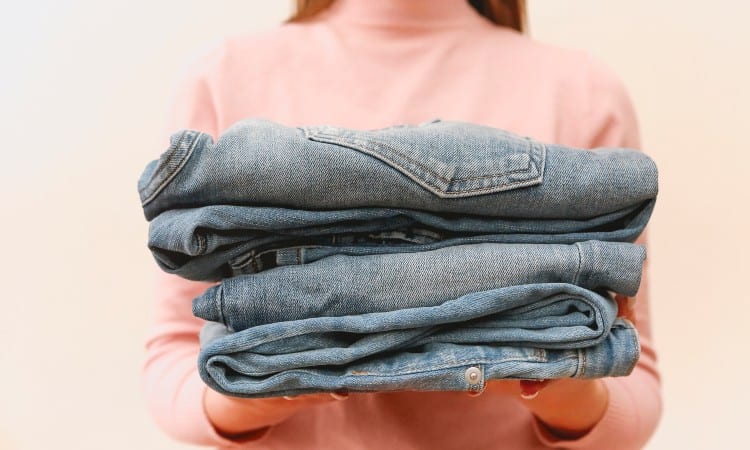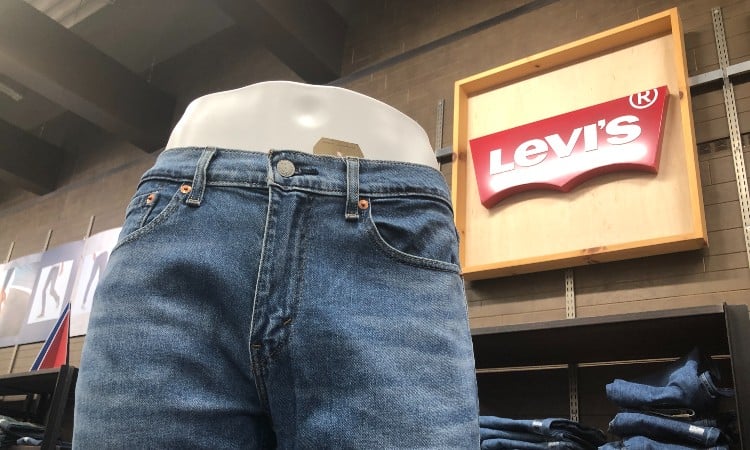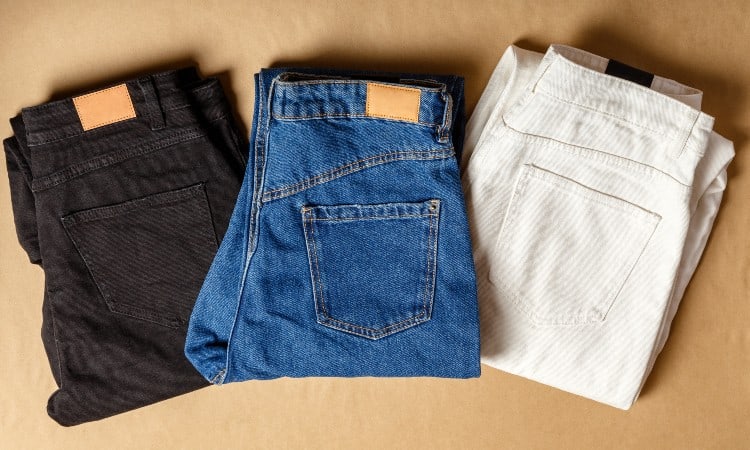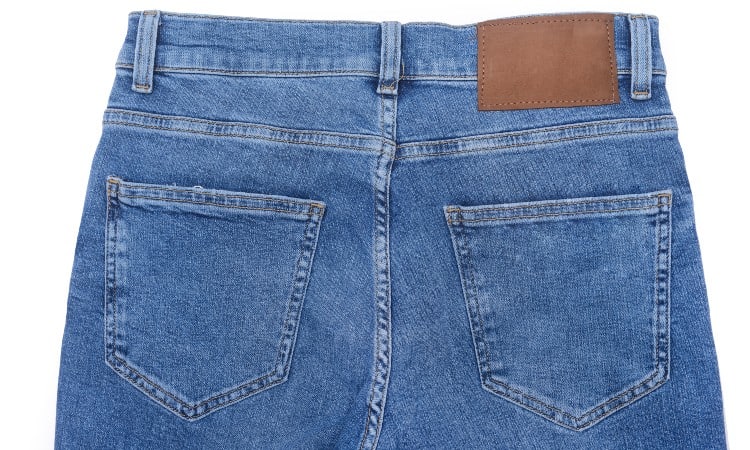I recently purchased a pair of denim jeans. The tag said they weighed 12.5 ounces. That sounds like an odd amount to me. So, when I got home, I weighed them. They were over 19 ounces! Why is there such a difference? Did they get heavier on the trip home? How come my denim jeans didn’t weigh 12.5 ounces? Just how much do jeans weigh?
Denim jeans have three weight categories. Lightweight jeans are less than 12 ounces. Midweight jeans are between 12-15 ounces. Heavyweight jeans are 16 ounces and over. The ounces refer to the weight of the denim fabric, not the weight of the jeans. A rating of 12.5 ounces indicates there are 12.5 ounces of denim per square yard of fabric.
This means the weight of your actual jeans can be different from the weight of the denim they contain. So how do you work out how much your jeans weigh? In this article, we’ll look at what to consider and how to weigh your jeans.

How Much Do Jeans Weigh?
The weight of any piece of clothing, including jeans, depends on several things. Fabric choice is one of the main contributing factors. Authentic denim made from 100% cotton will weigh more than a synthetic alternative.
Next, the style of the jeans will make a difference. Due to the fiber content, baggy or regular fit jeans will weigh heavier than skinny jeans. Tight-fitting jeans use stretch denim which contains elastane. The ability to stretch allows the jeans to be cut smaller and use less denim.
Another factor is the size of the item. Adult clothing, especially if it’s made from a heavy fabric like denim, will weigh more than a pair of jeans for a toddler. Simply because adult garments are bigger and contain more material.
Thread count or the thickness of the material used to make the jeans will alter the weight of the denim. A heavier weave will result in heavier jeans.
You’ll also find the number of pockets will make a difference as the more you have, the more material will be in the jeans. Rivets, zippers, and even the number of seams will also affect the overall weight.
Having said all that, jeans are a bit of an anomaly. The weight of 12.5 ounces listed on the price tag of those new Wranglers you bought isn’t referring to the weight of the jeans. Manufacturers don’t tend to weigh the finished garment. They weigh the denim. Or rather the amount of denim per square yard of fabric used to make the jeans.
How Are Jeans Weighed?
The simple answer is they aren’t. This is a little bit of a trick question. As we touched on in the first section of this article, it isn’t the weight of the actual jeans shown on the price tag. It’s the weight of the denim used to make them. So technically, the question should be, how is denim weighed?
Denim can be found in three weight classifications: lightweight, medium or mid-weight, and heavyweight. Each weight category will have a different thread count and weave, which increases as the fabric gets heavier.
Lightweight denim is the most flexible and soft of all the denim weights, making it easier to break in and more comfortable to wear. Heavyweight is the toughest and most durable. It’s also the hardest to wear out.
Jeans have been a part of fashion since the 1870s when they were first introduced as heavy-duty pants for working in. They were ideal for those with tough jobs like miners or farmers. These people needed a rough and rugged fabric to withstand days of continual rigorous manual labor.
Back then, weights around the globe were measured in the imperial system of pounds and ounces. Metric grams and kilograms weren’t a thing.
As we mentioned earlier, denim is weighed according to the amount of denim per square yard of fabric. It’s also based on the yarn count or amount of threads per inch. More threads per inch give harder wearing denim. They also make it heavier.
To make sure customers knew how durable their jeans were going to be, manufacturers started categorizing the denim by its weight. A weight system was introduced based on how many ounces, otherwise known as “oz”, denim were in a square yard.
Over time, ounces became the industry standard for weighing denim. Even today, when most of the world uses the metric system, denim fabric is still weighed by the ounce. It’s a tried and tested system. More importantly, it’s also trusted, so there’s no real need to change it.
If you’re not used to dealing with ounces, you may find the weight system confusing. Online converters will help you change the ounces per square yard to grams per square yard. This tool, for instance, may do the trick.
The following table shows the three typical categories used for measuring the weight of denim used in jeans. There isn’t an official standard as such. These figures are averages from across the jeans industry. You may find some brands consider anything less than 10 oz to be lightweight or over 14 oz to be heavyweight.
| Lightweight | Mediumweight | Heavyweight |
| Less than 12 oz | Between 12-15 oz | 16 oz and over |
Jeans Weight by Brand

When it comes to the weight of jeans, or rather the weight of the denim used to make them, it can differ depending on the brand. To find out how the weight of the fabric changes, we checked a range of styles from four of the top brand names in denim jeans.
Please note this is an overview of a small selection of products available from each company. It isn’t a reflection of all the jeans available from any brand. It’s more of a snapshot to give a rough idea of the weights each company uses.
Nor is it intended as a definitive list of weights used by the jeans industry as a whole. You may find other brands use different weights of denim. If you want to get a specific weight, make sure to check the label on the garment or ask about the denim quality at the store.
The following table shows the results of our research. As you can see, on average many of the jeans available from these brands range between 10.5-12.5 oz per square yard.
| Brand | Men’s Jeans | Women’s Jeans |
| Levi’s | Averages between 10.5-12.5 oz
per square yard |
Oz per square yard not given
Described by fit and style |
| Wrangler | Averages around 12.5 oz
per square yard |
Averages between 10-11 oz
per square yard |
| Lee | Oz per square yard not given
Described as mid or heavyweight |
Oz per square yard not given
Described by fit and style |
| Gap | Averages around 12.5 oz
per square yard |
Oz per square yard not given
Described by fit and style |
While conducting the research, we noticed there appears to be a disparity between how jeans are marketed. Men’s jeans typically state the weight of the denim used; women’s jeans focus more on the stretch content and fit.
This can make it difficult to assess the weight of the fabric used in women’s jeans. If we use Wrangler as an example, the oz per square yard in their denim for ladies is lightweight between 10-11 oz.
Which could indicate many jeans designed for women use light to midweight denim. At face value, this would appear to be a logical conclusion to come to. However, as information to back the theory up is difficult to come by, it’s just our best guess.
None of the brands specifically listed the actual weight of the denim garment for either men or women. Some other brands might, but, to be honest, if you want to know how heavy your jeans are, you may have to weigh them yourself at home.
Do Different Fabrics Change the Weight of Jeans?

Different fabrics can change the weight of jeans. In both the weight of the actual garment and the amount of denim per square yard.
It’s all down to the fibers within the fabric. Natural cotton-based denim is going to weigh heavier than a synthetic blend. Cotton, particularly when woven into a tight twill weave, is a durable fabric that is both hardwearing and strong. Those properties will make the fabric weigh more across a square yard of fabric.
If you add synthetic fiber to the mix, you’ll find the fabric needs less denim. The material will feel lighter by containing a lower percentage of natural fibers like cotton. This is because the synthetic fibers are thinner and usually hollow, meaning they don’t weigh as much as natural ones.
This fact means you can get heavier or tighter weaves of denim in a lighter-weight material. Add a slight hint of stretch with some spandex; you can even reduce the amount of denim you need in your jeans. Stretch fabric works on negative ease, which means the jeans can be cut smaller. Using less denim fabric will make your jeans weigh lighter.
Stretch Denim vs Nonstretch Denim: Is There a Weight Difference?
Although that depends on the fiber content, there isn’t necessarily a weight difference between stretch and nonstretch denim fabric. However, there will be a slight difference in the overall weight of the jeans made from that denim.
Nonstretch denim is going to contain a higher percentage of natural fiber. It will be either 100% cotton, which has no stretch, or a polycotton blend. Blends of cotton and polyester may have slightly more give, but they don’t stretch that much.
A pair of nonstretch jeans in size 14, will need the same amount of fabric regardless of whether it’s a blend or 100% cotton. The difference between the two comes down to the weight of the fibers. As synthetics are lighter than cotton, the polyester content will make the fabric weigh less than its 100% cotton equivalent.
On the other hand, stretch denim is not only lighter than 100% cotton, but it’s also more elastic. The whole point of stretch denim is to create figure-hugging jeans, made possible by something called negative ease. As the stretch allows the fabric to cover a larger area, garments can be cut smaller. So much so the amount of fabric used can be reduced. This will make your jeans lighter.
So basically, if you are comparing a nonstretch synthetic blend of denim with stretch denim, the chances are your jeans will weigh the same. A nonstretch 100% cotton denim will be heavier than a stretch version.
Of course, you still have to consider other factors. The number of pockets you have, the rivets, and even the size of the zipper can all make a difference. A weight difference between stretch vs nonstretch denim ultimately comes down to your jeans’ style and fabric content.
Are Men’s Jeans Heavier Than Women’s Jeans?

While it is possible for men’s jeans to weigh heavier than women’s, it’s not necessarily the case. In fact, as many jeans these days tend to be unisex, it makes the question a little moot.
The weight of jeans depends on the style, size, and fiber content rather than gender specifics. Let’s compare a pair of men’s jeans against a pair of women’s jeans. It will be tricky as clothing is sized differently for each gender, but we’ll give it a go.
We’ll use the example of a pair of men’s jeans in 12.5 oz midweight denim. He has a 52-inch waist and a 40-inch leg, that’s quite big. Next, a pair of lightweight ladies’ jeans in size zero, which is the other end of the spectrum and very small.
The amount of denim in the ladies’ jeans will be a lot less than in the men’s, making her jeans lighter. Not because they are hers, but because she is smaller. It could also be because her jeans are stretch and his are a regular fit.
Now, women’s jeans aren’t restricted to stretch options. Nor are they limited to lighter weight denim. Women can also have regular fit jeans in a 12 oz midweight. The fit and denim in this example will bring the weight of the jeans closer to the men’s jeans we looked at. Especially if you change the size of the women’s jeans to a 16.
With jeans, it is based on your size, fabric, and fit. It’s also down to your preference in style. Your gender has nothing to do with it.
Are Pockets a Factor in How Much Jeans Weigh?

Yes, pockets can make a difference to the overall weight of a pair of jeans. Pockets use extra fabric. While this material tends to be lightweight cotton or lining fabric, it still adds ounces to the weight of your jeans.
The pockets of jeans tend to have rivets to reinforce them. Rivets are usually made from metal, so the number of pockets and amount of rivets on each one will increase the weight. So too, will any kind of embellishment or embroidery design on the pockets, particularly the back pockets.
One thing that can be gender-specific on jeans is the size of the pockets. However, this is something that is across the board with clothing rather than being an issue with just jeans. Men’s pockets are functional and therefore tend to be larger.
Pockets for women are a lot smaller. Most aren’t even real pockets but are purely decorative. This seemingly insignificant fact is slightly irritating to women and makes a difference to the weight of jeans.
How Do You Weigh Your Own Jeans
Now you know a 14oz pair of jeans doesn’t weigh 14oz, you’re probably wondering how you can weigh your jeans to get a more accurate figure for the garment. Especially as manufacturers don’t weigh the actual jeans, only the weight of the denim.
The easiest way is to use a set of scales. Let’s take a look at a couple of options for weighing your denim jeans.
Kitchen Scales
Kitchen scales are really handy when it comes to weighing jeans. Some have a range of weight measurement options allowing you to weigh your jeans in pounds (lbs) or even grams (g).
All you have to do is roll your jeans up, so they are small enough to fit on the scales. Select your preferred weight unit and make sure your scales are set to zero. Then, simply put your jeans on the scales and make a note of the weight it shows.
Bathroom Scales
Bathroom scales work a little differently from kitchen scales. They don’t tend to be as sensitive or have as many measurement options.
As with the kitchen scales, roll your jeans up, so they fit on the scales. Calibrate your scales, so they are at zero and place your jeans on them. You may find your jeans are too light to register on your bathroom scales, so you may need to try a different method.
Wearing nothing but your underwear, stand on your calibrated bathroom scales. Make a note of the weight. Next, stand on the scales wearing your underwear and your jeans. Again, note down the measurement. Subtracting your pre-jeans weight from your with-jeans weight will give you the weight of your jeans.
Why You Need to Know How Much Jeans Weigh
There are several reasons why you need to know how much jeans weigh. The main reason is to make sure you get the right weight for the weather conditions or climate you happen to be in.
If you live in a region where temperatures regularly get hot and steamy, you’ll want to make sure you have lightweight jeans. Otherwise, you’ll overheat. Similarly, for a hike through the woods, you’ll find a lighter pair of jeans easier to move in.
When airplanes feature in your travel plans, you’ll need to know how heavy your jeans are before packing. Planes have baggage limits requiring you to be under a certain weight. A sturdy pair of jeans weighing in at 16 oz could tip you over the limit. Knowing this beforehand will help you decide to pack your heavy denim pants or wear them.
One thing many of us don’t consider when it comes to the weight of our jeans is washing them. Jeans weigh heavier when they are wet. This is true whether they are synthetic or all-natural denim.
Washing machine drums are balanced to spin and rotate at the perfect angle and speed for a successful wash. Too many pairs of 14 oz jeans in the drum at the same time can have a negative impact on your washing machine, leading to damage to the machine. Or worse, badly washed jeans.
The next reason for knowing the weight of your jeans probably only applies to online sellers. For those of you who sell on sites like eBay, Etsy, or even Facebook Marketplace, you’re going to need to know the cost of shipping.
How much your jeans weigh will make a difference to those shipping costs. Not just on their own either. You’ll need to know the weight of the jeans plus the packaging. Otherwise, you could find any profit you made selling your jeans is eaten away by the cost of mailing them out.
Conclusion
Jeans come in three weight categories. Lightweight, midweight, and heavyweight. The weights are based on the ounces of denim per square yard of fabric. Not the weight of the actual garment.
Denim jeans can weigh a lot more than the fabric they contain. A garment’s weight is based on size, amount of fabric, embellishments, fit, and the type of denim used.
Have you tried weighing your denim jeans? What method did you use? Were you surprised by how much your jeans weigh?